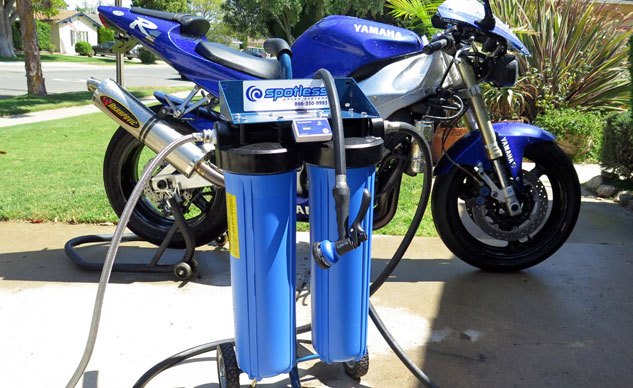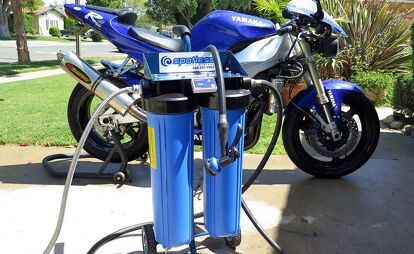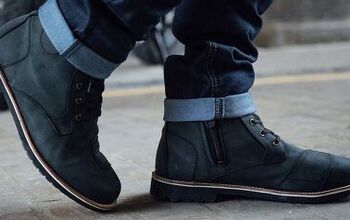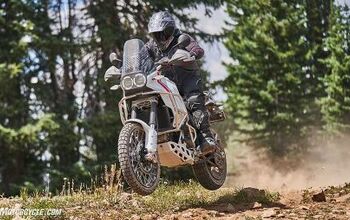MO Tested: CR Spotless Water Systems Bike Washer
Possibly the next best thing to showering with a friend
I didn’t need a CR Spotless Water Systems Deionizing water filter deal, but now that I have one it’s hard to see how I could go on living without it. When CR’s nice PR woman asked if I’d like to try one, I almost didn’t. I’ve used the “Spot-Free Rinse” at the car wash, which I decided is probably a bad translation from the Chinese “Free Spots 25 Cents”. Rinse your thing with this CR Spotless deionized water, and you’re supposed to be able to walk away and let mother nature do the drying without worrying about unsightly water spots.
How could this possibly work? You have to dry things after you wash them or you’ll have spots: Cars, motorcycles, wine glasses are all the same. Frankly, drying my motorcycles after I wash them has never seemed like that big a chore to me, since here in sunny SoCal I don’t wash them much. (My bud Jim takes weird pride in the fact that his Ducati has never been touched by soap or water.) The average bike doesn’t really have all that much surface area, and there’s no way to get all the nooks and crannies dry anyway. Besides, drying your bike after you wash it, even half-assedly, is a good time to give all systems a good eye-balling. It’s kind of a labor of love. On the other hand, drying your car (provided you have one you actually care about keeping clean and shiny) quickly gets to be a PITA.
Supposedly, the key here is deionization via ion exchange, as your hose water passes through a special resin which removes all the minerals and salts and things which are normally left behind when a drop of water dries on your paint. You can read all about it at CR’s FAQ page.
Everything needed came in the box with my DIC-20 system, including Teflon tape. Screw on the two big plastic cartridges which contain the resin, screw the supplied stainless steel hose between your bib and the IN bib on the CR system, attach your garden hose to the OUT, and turn on the water.
I started off with the hardest test, because I didn’t believe this thing could possibly work: I parked my ’97 Shaguar in the hot March sun and soaped it up, a thing I would never normally do. It was hot enough that I had to work quick to rinse the car off with the Spotless system before the soapy water dried. The car does have a decent coat of wax on it; the water beaded up and I chilled with a beverage to await the results.
Ah, yup, the car dried completely spotlessly and looked cleaner than ever. I’d always dried it in the shade whenever possible, with a synthetic chamois and a towel – especially the glass, which would always wind up a little streaky anyway. But when the CR Spotless deionized water had evaporated from the glass and chrome, those areas were more streak-free and shiny than I’d ever seen them, and totally spotless and clean. Amazing, really. Even the rubber looked somehow better than usual.
The real test might be some really chrome-encrusted bike like a Heritage Softail Springer or something, but we didn’t have one on hand. I rolled my naked R1 out in the sun instead alongside our Yamaha TMax scooter in flat black, soaped them both up, instrument panels and all, and rinsed both with the Spotless deionized water. They both also dried perfectly spot-free and beautiful, with not a single swipe of towel to either one, and the R1 is the cleanest I’ve ever seen it, particularly in all the impossible-to-reach areas.
If I hadn’t seen it with my own eyeballs, I wouldn’t have believed it. The downside is it ain’t exactly cheap. The DIC-20 CR sent me to test sells for $449.95, though there is a DI-120 system for $249.95 with one filter cartridge instead of two. The expensive part of the equation is that the resin doesn’t last all that long. Our DIC-20 is a “300-gallon” system, meaning that you’ll get around that much deionized water out of it, depending on the quality of the water you put into it, before you’ll need to replace the resin packs. And you’re looking at $90 per replacement.
CR Spotless’ Director of Sales and Marketing John Fernandez says he washes two or three cars a week and replaces his cartridges every 10-12 weeks. At that rate, he says, it boils down to about a $25-a-month habit. A lot of it depends on the “TDS” of your water supply: Total Dissolved Solids are the total amount of mobile charged ions, including minerals, salts or metals dissolved in a given volume of water, expressed in units of mg per unit volume of water (mg/L), or parts per million (ppm). Fernandez says his SoCal water supply has a TDS of about 250, but it can vary from 175 to 500 depending on where you live, meaning the 300-gallon model deionizer might produce as few as 155 gallons or as many as 435. “Think of it as a couple martinis a month habit, and you’ll be fine,” says Hernandez, “It’s what you pay for the magic.” I like how he thinks. Anyway, you know it’s time for fresh resin when the system’s electronic TDS meter reaches 20. Mine’s still at 0000.
Just as I was about to wash my car, I heard on the garage radio that Jerry Brown had called for a 25% reduction in water use for California. Good thing the CR is pretty miserly with water. The DIC-20 has a maximum flow rate of 2.5 gallons per minute, and the instructions are to only use the low settings on the provided nozzle. Again, my California car stays pretty clean most of the time. I can fill a bucket with about 1.5 gallons of water and a little detergent and soap up the whole thing. And if it takes two minutes to rinse with the Spotless water, that’s maybe six gallons total. A good wash and rinse of my R1 used less than half that amount I bet, and if you were only using the CR to wash motorcycles, your resin would last a long time. Another water-saving option is to plumb the deionizer in upstream of your pressure washer, if you use one, since the typical pressure washer slows flow to less than 2 gpm. Then your CR system becomes also great for washing dirty dirtbikes and monster trucks, along with windows and solar panels.
Wow, this is an awesome product if you can swing it, and if you wash lots of bikes or cars or whatever, it seems almost like a must-have. You’ll be using zero water to launder your drying towels anymore, and the time you spent drying can now be used for drinking a beer or two, further conserving water. Kudos…
More by John Burns




































Comments
Join the conversation
Neat idea. Glad it works so well but for that amount of $$, I'l keep on with washing and drying in the shade for about 25 cents per. If you have hard water, a little Jet-Dry rinse agent in the soapy water helps reduce spots.
I had a bird crap on my bike after washing. One stain that is hard to get rid of no matter the system you use.